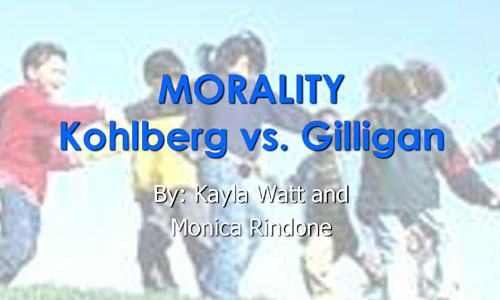Difference between GILLIGAN and KOHLBERG CONTROVERSY
Introduction
Professor Jean Piaget’s study on evolution of thinking pattern of individual human beings and its influence on moral development of the person is an interesting subject of psychology. Highly appreciative of Piaget’s view, Lawrence Kohlberg in 1960 constituted a six stage model to demonstrate how individual’s morality develops through the stages. Carol Gilligan, a student and colleague of Kohlberg, however noted that Kohlberg collected data from affluent middle-class male only, which resulted in females scoring consistently at stage 3 and males at stage 4 & 5, when the model was applied to them. The point of contention is that Kohlberg’s model directs to inferior morality of women as compared to men, which Carol Gilligan noticed and opposed. Gilligan researched and constitutes her own model, which later, Kohlberg did not challenge.
The differences
Basic tenet
Lawrence Kohlberg’s model of evolution of morality is based upon the principle that human beings make decisions on the basis of universal, abstract principles of justice, duty, and impartial reasoning, and logic. Carol Gilligan’s ‘ethics of care’ principle, which was at the centre of her model, is based on the basic tenet that, female psychology, values, and even moral structure differ from that of males. She claims that women are inherently inclined towards care and responsibility to others. She developed a relational theory to demonstrate the development of female morality.
Construction of model
Kohlberg’s model consists of three stages; each stage is divided into two sub-stages. Stage 1(birth to 9 years) – Pre-conventional stage: moral development at this stage is self-ego centric, where actions are oriented towards fear of punishment by authorities in home and outside. Stage 2 (10 – 20years) – Conventional stage: human beings at this stage start and learn to see things from others’ point of view, respect what others expect from them. Stage 3 (20 years onwards) – Post-conventional stage: In this stage people make moral judgments based on logic, impartial reasoning, and universally accepted abstract principles of justice.
GILLIGAN & KOHLBERG CONTROVERSY
Human beings at this stage judge actions in the perspective of universal right or wrong, irrespective of their culture. Moral orientation at this stage is towards common-good rather self-good. According to Kohlberg, few people reach this stage, and those who reach are revered by the society.
Carol Gilligan based upon her ‘care of ethics’, developed a 3-stage development model. Stage 1- Pre-conventional stage: A girl-child’s morality is self-and-others oriented, and she does what she thinks best for her to do. Stage 2 – Conventional stage: At this stage care for others takes the front seat. Women at this stage develop sense of respect for and responsibility to others, and also the element of self-sacrifice gets rooted in their psyche. Post-conventional stage: At this stage women learn and practice to equate personal needs with that of others, and the focus shifts to dynamic relationship. In the later part of this stage care does not remain confined to personal relationship, but extends inter-personal relationship, like condemnation of violence against and exploitation of human beings.
Study
The famous story of dilemma, where a woman was suffering from a terminal disease, and her husband, being unable to buy the only drug for his wife, was left with no option but to steal the medicine, was used by Gilligan in the case study involving two children Jake and Amy. The question asked to them was; should the husband named Heinz, steal the medicine, or see his wife dying without the medicine. Jake gave a straight forward answer; Heinz should steal the medicine to save his wife. Hr argued that value of human life is far more than that of the medicine. Jake’s answer was clearly based upon rationality. He even challenged the law against stealing as obstacle in the way of Heinz stealing the drug. Amy’s answer to the same question put her one full stage lower than that of Jake, as per Kohlberg’s criteria. Amy’s answer was unsure. She claimed that the man should not steal the drug, but at the same time his wife also should not die. Her argument was, should the man get caught while stealing would be jailed, and there would be no one to take care of his ailing wife. She even emphasised that Heinz should borrow money, negotiate on the price, to arrange for the medicine. Gilligan argues that this difference in opinion between Jake and Amy is due to the fact that Amy, unlike Jake, does not see the problem through the prism of rationality, rather care and love.
GILLIGAN & KOHLBERG CONTROVERSY
Conclusion
Kohlberg’s study of moral evolution was based on rationality and justice. He based his model on a study conducted upon 72 males, belonging to upper class and middle class. Females were not included in his study. Gilligan challenged this. She constructed her model for females, on the basis of inherent characteristic of women, which is care and inter-personal relationship. Kohlberg never challenged Gilligan, his one-time student and colleague, rather embraced Gilligan’s view, and considered Gilligan’s model as complimentary to his own model.
Summary
(1) Kohlberg’s model is male centric, and does not give complete picture of the process of moral development of human beings. Gilligan challenged this and constitutes separate model of women.
(2) Kohlberg’s theory is based upon rationality, duty, impartiality, and universally accepted abstract principle of justice. Gilligan’s model is based upon female characteristics of care and relationship.
(3) Women as per Kohlberg’s model are inferior to men so long as moral development is concerned. Gilligan made this impression null & void by incorporating in her model female traits of care and love.
- Differences between Al-Qaeda And ISIS - April 14, 2017
- Difference Between Hindu And Buddhist meditation - September 20, 2015
- Difference Between Upper Middle Class and Lower Middle Class - September 3, 2015
Search DifferenceBetween.net :
Leave a Response
References :
[0]https://www.google.com/search?bih=671&biw=1280&noj=1&tbm=isch&sa=1&q=GILLIGAN+%26+KOHLBERG+CONTROVERSY&oq=GILLIGAN+%26+KOHLBERG+CONTROVERSY&gs_l=img.12...3471.3471.0.4520.1.1.0.0.0.0.0.0..0.0....0...1c..58.img..1.0.0.2os9xPO8ZCM#facrc=_&imgdii=_&imgrc=fyVpuoTrTVzeKM%253A%3BlfpQWNT-5uH2vM%3Bhttp%253A%252F%252Fimg.docstoccdn.com%252Fthumb%252Forig%252F103204686.png%3Bhttp%253A%252F%252Fgalleryhip.com%252Fpreconventional-morality.html%3B1500%3B1125

